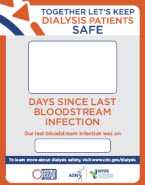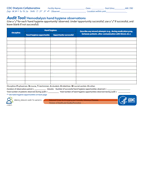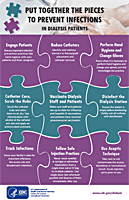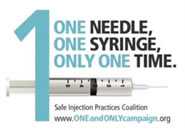Clinician Education
On this Page
Bloodstream infections are a dangerous complication of dialysis. In the U.S., there are about 370,000 people relying on hemodialysis care. These patients are at risk of getting serious infections.
About 75,000 people receive hemodialysis through a central line. Central lines have a higher risk of infection than a fistula or graft. The CDC estimates that 37,000 central line-associated bloodstream infections may have occurred in U.S. hemodialysis patients in 2008.
It’s important for physicians, nurses, dialysis technicians, and all healthcare workers to understand and follow proper infection control procedures. The resources on this page are designed to help dialysis clinicians understand the basics of infection control.
Staff Competencies
Assess staff upon hire and at least yearly in the following competencies (Note: not all categories will be applicable to all staff):
Gloving and hand hygiene (all staff) – includes recognition of appropriate situations for glove use/hand hygiene, proper use and removal of gloves, and proper hand hygiene technique.
Catheter dressing change technique – includes correct performance of hand hygiene, and use of gloves, and correct use of antiseptics (proper application and allow drying, etc).
Vascular access technique – includes correct performance of hand hygiene and use of gloves, catheter site and port/vascular access antisepsis, and aseptic technique.
Safe injection/safe medication practices – includes proper technique for
- parenteral medication preparation, handling, administration and storage (e.g., not in patient station, etc.)
- use of aseptic technique,
- proper hand hygiene before preparing or administering medications or infusions
- proper cleansing of medication injection ports and medication vial diaphragms.
- proper use and handling of single use vials and bags.
Areas for Patient Education
Patients with catheters:
- Hand hygiene
- General access care at home (e.g., bathing with a catheter)
- Signs and symptoms of infection
- How to respond if problems with catheter develop outside of the dialysis center
- Risks associated with catheters/importance of permanent access
- Basic infection control practices during catheter accessing process (as a means to engage patients)
Patients with other access types:
- Hand hygiene
- Washing the access site prior to treatment
- General access care at home (e.g., don’t scratch or pick at the site)
- Signs and symptoms of infection
- How to respond if problems with access develop outside of the dialysis center
- Basic infection control practices during cannulation process (as a means to engage patients)
Training and Resources
Days Since Infection Posters

Preventing infections is essential for patient safety. This wall poster can be used to display the number of days that have passed since the last bloodstream infection in your facility.
Facilities are encouraged to place this poster in areas visible to patients, family members, and staff to start discussion and provide education opportunities about the importance of preventing bloodstream infections. The poster is available in two sizes and in a print version or fillable version that includes a placeholder for your organization’s logo. Laminated copies of the print version can be ordered for free from CDC-Info on Demand.
| Fillable version (add your organization logo) | Non Fillable version (available in print) |
|---|---|
| 8.5 x 11 (Print Only) [PDF – 1 page] | 8.5 x 11 (Print Only) [PDF – 1 page] Pub ID 300199 |
Infection Prevention Audit Tools and Checklists

The Prevention Tools page has tools and checklists to improve infection prevention.
Preventing Bloodstream Infections in Outpatient Hemodialysis Patients

CDC has created a video for frontline dialysis staff along with an accompanying poster for staff and pocket card for patients that convey best practices for preventing bloodstream and other infections in hemodialysis outpatients. Use as an educational tool in hemodialysis facilities as orientation for new staff or annual in-service training.
| English version | Spanish Version |
|---|---|
| YouTube Link | YouTube link |

This 11×17 wall poster is a visual reminder of measures that staff can take to reduce infection in dialysis patients. The elements include Engage Patients, Reduce Catheters, Perform Hand Hygiene and Change Gloves, Catheter Care, Vaccinate Staff and Patients, Disinfect the Dialysis Station, Track Infections, Follow Safe Injection Practices, and Use Aseptic Technique.
Order Infection Prevention and Education Resources
Visit the Making Dialysis Safer for Patients Resource Center
Continuing Education: Infection Prevention in Dialysis Settings

Get Continuing Education for this computer-based training on how to prevent infections in outpatient dialysis settings.
Safe Injection Practices – How to Do it Right

Healthcare providers can understand safe injection practices by viewing this unique animated video. This video highlights the importance of using single-dose vials one time for one patient by following the story of Joe, a patient who ended up in the hospital with an infection as a result of unsafe injection practices.
Safe Injection Practices: Protecting Yourself and Your Patients

Healthcare providers can understand safe injection practices by viewing this unique animated video. This video highlights the importance of using single-dose vials one time for one patient by following the story of Joe, a patient who ended up in the hospital with an infection as a result of unsafe injection practices.
- Page last reviewed: September 5, 2017
- Page last updated: September 5, 2017
- Content source:


 ShareCompartir
ShareCompartir

